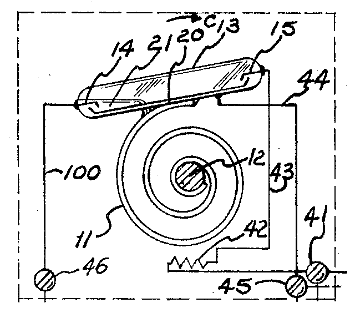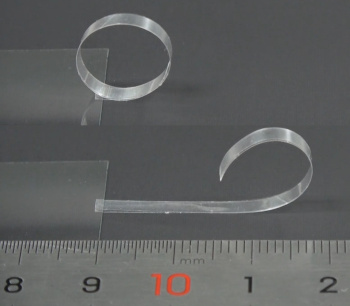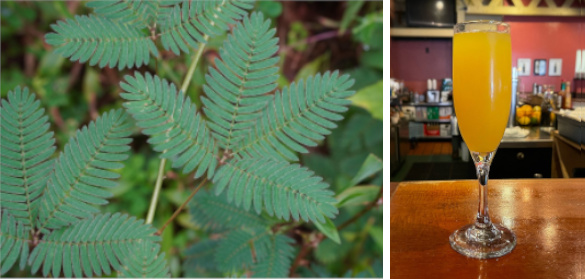Passive Thermal Management
November 21, 2022
Before
thermostats became just another of the many
electronic gadgets used in our
homes, their operating
principle was
mechanical.
Electrical contacts were opened and closed by action of
liquid mercury, a
conductive metal, inside a
sealed glass bulb. The
switch state was controlled by
temperature responsive motion of a
bimetallic metal strip. The
differential thermal expansion of
two metal strips bonded together, typically by
welding, causes the bimetallic strip to
bend (see figure). Temperature
control was improved in thermally
sluggish home heating systems by the addition of a small
in-circuit adjustable resistor inside the thermostat. This so-called
anticipation heater applied a small amount of
heat to the thermostat so it would turn off somewhat earlier.

Portion of fig. 1 of United States Patent No. 3,284,002, "Control Apparatus," by Walter E. Edelman and David J. Sutton, October 26, 1964.
This is the iconic Honeywell T87 Round Thermostat containing a bimetallic element (11) that moves a mercury switch (13).
(Via Google Patents.)
![]()
Fortunately for the thermostat application, the
thermal expansion coefficient of metals varies over a wide range (see table), as does that of
metal alloys. A common bimetallic couple is
steel (12 x 10
-6/
K) paired with
brass (18.7 x 10
-6/K) or
copper (16.5 x 10
-6/K). In most other applications, thermal expansion is a problem that causes
dimensional change of
mechanical components and
delamination of
coatings.
As a consequence of their different
atomic bonding,
polymers have thermal expansion coefficients that are many time larger than those of metals (see table). A bipolymeric strip made from bonding two dissimilar polymers will produce a much larger mechanical change with temperature than a bimetallic strip.
As
researchers from
Nankai University (Tianjin, China) have shown, bipolymeric strips can be used in a device for
passive thermal management.[2-4] The strips
uncoil as temperature is increased to
emit infrared radiation and thereby
cool a lower
thermochromic material.[2,4] This thermochromic material will change
color when lower temperature causes the strips to
coil and allow passage of
sunlight.[2,4] The color change allows more sunlight to be
absorbed to heat the thermochromic material.[2,4] As the
authors write, "The combination of
visible and infrared “thermochromism” enables this device to freely switch between
solar heating and radiative cooling modes by spontaneously perceiving the temperature without any external
energy consumption."[2] In one mode, the device captures heat from the sun; and, in the other mode, it radiates heat into the cold of
outer space.

Uncoiling of bipolymeric strip during heating.
As the research team writes in its paper, the threshold temperature for switching between the coiled and uncoiled states can be adjusted by careful choice of the bipolymeric materials and the thermochromic material coating the substrate.[2]
I haven't read the full research paper, since it's paywalled, but the bipolymeric layers are evidently bonded together on a cylindrical mandrel to achieve their initial coiled state.
(Still images from supplementary video for Ref. 2.[3])
The paper authors state that they were
inspired by
biological stress responses in
nature, such as the opening-folding movement of the
leaves of the
Mimosa pudica, which
modulates their infrared emissivity.[2] The leaves of this
plant fold inward and droop when touched to defend them from harm, and they return to their original state a few
minutes later. Its
foliage also closes in
darkness and it reopens in
light, giving a thermal response like that of the
Chinese device.

Mimosa plant and mimosa cocktail. My wife had a potted mimosa pudica in our apartment when we were first married. The mimosa cocktail is named after a different plant of the same color, the yellow-flowered Acacia dealbata. A mimosa cocktail is usually mixed from champagne and chilled orange juice, and it's a common party drink that's not too potent in usual volumes. (Left, portion Wikimedia Commons image by Vengolis. Right, portion of a Wikimedia Commons image by Sarah Stierch.)
Nearly half of
global energy consumption comes from heating and cooling.[4] Older
office buildings were built with huge
glass windows, and this was the case for a
corporate campus at which I worked in the
1980s. At one point, it was decided to apply a thermochromic
film to the windows of several buildings as an
energy conservation measure, possibly
motivated by some
tax incentives. Color-changing windows such as these can do either heating or cooling, but not both as in the Chinese device.[4]
Laboratory tests of a four
centimeter by four centimeter device
demonstrated survival for 500 coiling cycles.[4] Other measurements revealed that the device has a solar heating power of about 250
W/
m2 and a cooling power of about 60 W/m
2.[4]
References:
- Table of polymer thermal expansion coefficients at omnexus.specialchem.com.
- Quan Zhang, Yufeng Wang, Yiwen Lv, Shixiong Yu, and Rujun Ma, "Bioinspired zero-energy thermal-management device based on visible and infrared thermochromism for all-season energy saving," Proc. Natl. Acad. Sci., vol. 119, no. 38 (September 12, 2022), Article no. e2207353119, https://doi.org/10.1073/pnas.2207353119.
- Supplementary Information for Ref. 2 (PDF file). Two videos of the device action can be found here and here.
- Prachi Patel, "Zero-Energy Tech Heats When Cold and Cools When Hot," IEEE Spectrum, September 22, 2022.
Linked Keywords: Thermostat; consumer electronics; electronic gadget; home; principle; mechanics; mechanical; electricity; electrical; contactor; contact; liquid; mercury (element); electrical conductor; conductive; metal; mercury switch; sealed glass bulb; switch; temperature; response; responsive; motion (physics); bimetallic strip; metal strip; differential; thermal expansion; two metal strips bonded together; welding; deflection (engineering); bend; control system; sluggish; central heating; home heating system; electronic circuit; in-circuit; potentiometer; adjustable resistor; electric heating; heater; heat; United States; patent; cultural icon; iconic; Honeywell; Honeywell T87; T87 Round Thermostat; bimetallic element; Google Patents; thermal expansion coefficient; metal alloy; steel; kelvin; K; brass; copper; dimension; dimensional; machine; mechanical component; delamination; coating; room temperature (cientific use); chemical element; elemental; metal; thermal expansion coefficients of the elements (data page); Wikipedia data page; lithium; beryllium; magnesium; aluminum; silicon; titanium; vanadium; chromium; manganese; iron; cobalt; nickel; copper; zinc; germanium; yttrium; zirconium; niobium; molybdenum; ruthenium; rhodium; palladium; silver; cadmium; tin; antimony; hafnium; tantalum; tungsten; rhenium; osmium; iridium; platinum; gold; lead; bismuth; thorium; uranium; atom; atomic; chemical bond; bonding; polymer; EVA - Ethylene Vinyl Acetate; PI - Polyimide; PS - Polystyrene (Crystal); CPVC - Chlorinated Polyvinyl Chloride; PET - Polyethylene Terephthalate; PMMA - Polymethylmethacrylate Acrylic; SAN - Styrene Acrylonitrile; PEEK - Polyetheretherketone; PBT - Polybutylene Terephthalate; PC - Polycarbonate; ASA - Acrylonitrile Styrene Acrylate; HDPE - High Density Polyethylene; PA 6 - Polyamide 6 (nylon 6); XLPE - Crosslinked Polyethylene; XABS - Acrylonitrile Butadiene Styrene; PVDF - Polyvinylidene Fluoride; HIPS - High Impact Polystyrene; POM - Polyoxymethylene (Acetal); PVC - Polyvinyl Chloride; CA - Cellulose Acetate; CAB - Cellulose Acetate Butyrate; PTFE - Polytetrafluoroethylene (Teflon); LDPE - Low Density Polyethylene; PVDC - Polyvinylidene Chloride; PCL - Polycaprolactone; research; researcher; Nankai University (Tianjin, China); passive daytime radiative cooling; passive thermal management; coil; uncoil; emissivity; emit; infrared; electromagnetic radiation; cooling; cool; thermochromism; thermochromic; material; color; sunlight; absorption (electromagnetic radiation); absorb; author; visible spectrum; Sun; solar; energy; consumption (economics); outer space; uncoiling; bipolymeric; strip; heat; heating; scientific literature; paper; threshold model; threshold; coating; substrate (materials science); paywall; paywalled; direct bonding; bonded; cylinder (geometry); cylindrical; mandrel; inspiration; inspired; biology; biological; stress (biology); nature; leaf; leaves; Mimosa pudica; modulation; modulate; plant; minute; foliage; darkness; light; China; Chinese; mimosa cocktail; wife; houseplant; potted; apartment; marriage; married; color; yellow; flower; flowered; Acacia dealbata; mixed drink; champagne; cold; chilled; orange juice; cocktail party; potency (pharmacology); potent; volume; Wikimedia Commons; Vengolis; Sarah Stierch; global energy consumption; office building; glass; window; corporation; corporate; campus; 1980s; film (coating); energy conservation; motivation; motivated; tax incentives; laboratory; evaluation; test; centimeter; demonstrate; demonstrated; resilience; survival; watt; square meter; m2.